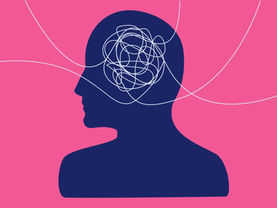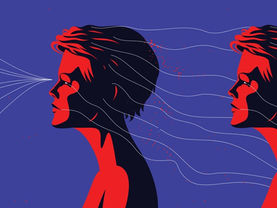Why You Can’t Just 'Snap Out of It': The Hidden Logic of Panic Attacks
- Chaimae Oulhadj
- Jul 21
- 4 min read
It doesn’t always look like screaming or hyperventilating. Sometimes, it’s quiet. Too quiet. I could be sitting on the couch, scrolling through my phone or staring at the wall, and suddenly, it hits.
My chest gets heavy. My thoughts blur. The world doesn’t feel real. And I just sit there–-frozen; while my brain quietly spirals into panic.
That’s the thing about panic attacks: they wear different faces. For some, it’s shaking hands and racing hearts. For others, like me, it’s a silent storm. And the worst part? You try to reason with it. You tell yourself, “Nothing’s wrong. I’m fine.” But the panic doesn’t care about logic. It just takes over, it doesn't give you time to think your way out of it. People usually just advise you to remain calm and focus on your breathing but very few actually explain why your body goes into alarm mode and what really resets it.
What actually happens during a panic attack
Since we can’t read the next chapter without understanding the prologue first, let’s start by getting a grasp of what panic attacks are.
It starts in the amygdala, the part of your brain responsible for detecting threats. When it perceives danger (whether it’s real or not) it activates the sympathetic nervous system, triggering the fight, flight, or freeze response. This causes a rush of physical changes: your heart rate increases, breathing becomes rapid, and muscles tense. You may feel dizzy, nauseous, sweaty, or even detached from reality which is a response called derealization or depersonalization.
Meanwhile, the prefrontal cortex (the area responsible for rational thinking and decision-making) gets overridden. That’s why you can’t just "think" your way out of it. During that moment your brain is prioritizing survival, not logic.
Panic: a multifaceted mask
Panic attacks can show up in lots of different ways. Some people have strong symptoms like a fast heartbeat, rapid breathing, or shaking. Others might feel more quiet symptoms, like feeling disconnected from themselves or their surroundings, or freezing up and unable to move. These differences happen because our brains and bodies react in different ways to stress. If panic attacks happen again and again, they can cause something called anticipatory anxiety; which means you start worrying about when the next attack might come. This makes your body stay on high alert, and you might even avoid certain places or situations because you’re scared the panic will come back. That’s how the cycle of panic and anxiety keeps going.
Untangling the Rubik’s Cube of Panic Attacks
When a panic attack happens, the part of your brain that helps you think clearly (the prefrontal cortex) actually slows down or shuts off. During this time, your brain isn’t ignoring you because you’re weak, it’s protecting you by making you feel disconnected.
That means that your logical thinking is temporarily offline, and your brain is focused on reacting fast to what it thinks is danger.
The good news? You can train your brain to feel safe again. This is where the polyvagal theory comes in, developed by Stephen Porges. It emphasizes the role of the autonomic nervous system; It explains how a nerve called the vagus nerve helps control your body’s relaxation response by doing repetitive practices like cold facial immersion, adequate sleep,and even laughter. When you calm this nerve, your body can reset from panic and stress. Over time, these tools can help you untangle the complicated “Rubik’s Cube” of panic attacks, its loops,and regain control.
Navigating through the storm: learning how to swim toward calm
Now that we’ve covered long-term strategies to break the cycle of panic attacks, here are some practical steps to take when you feel an attack coming on. During the onset of a panic attack, grounding yourself with the 5-4-3-2-1 technique: identifying 5 things you see, 4 you can touch, 3 you hear, 2 you smell, and 1 you taste; helps engage the prefrontal cortex which supports rational thought and can help inhibit the overactive amygdala (the brain’s fear center). Practicing slow, deep breathing such as inhaling for 4 seconds, holding for 4, and exhaling for 6 stimulates the vagus nerve, promoting parasympathetic activation (your body’s “rest and digest” system that calms your heart rate and relaxes your muscles) and reducing sympathetic overdrive. Applying cold water to the face or holding ice stimulates the mammalian dive reflex, triggering vagal tone and lowering heart rate. Gentle movements, like shaking your limbs or walking, help dissipate muscle tension and send proprioceptive feedback that assists in calming the nervous system. Throughout this process, affirming to yourself, “I am safe. This will pass” can reinforce cognitive control. While these methods may not immediately stop the panic, they facilitate neural regulation and help your body return to a calmer state, making the episode more manageable.
The Scent of Fresh Earth After the Storm
Panic doesn’t define you; it’s just a storm passing through your mind. Your body isn’t betraying you; it’s trying to protect you, sounding an alarm when it mistakes shadows for danger. Each panic attack is not a defeat but a challenge you’re growing stronger to face. With time, patience, and the right tools, you’ll teach your nervous system to recognize safety again.
Remember: you are not the storm. You are the calm that follows it–-the fresh, earthy scent that rises after the rain, grounding and renewing everything it touches!!















Comments